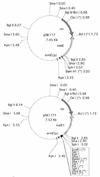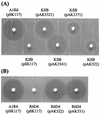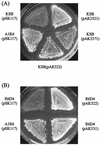The rpoZ gene, encoding the RNA polymerase omega subunit, is required for antibiotic production and morphological differentiation in Streptomyces kasugaensis
- PMID: 12426327
- PMCID: PMC135429
- DOI: 10.1128/JB.184.23.6417-6423.2002
The rpoZ gene, encoding the RNA polymerase omega subunit, is required for antibiotic production and morphological differentiation in Streptomyces kasugaensis
Erratum in
- J Bacteriol. 2003 Jan;185(1):386
Abstract
The occurrence of pleiotropic mutants that are defective in both antibiotic production and aerial mycelium formation is peculiar to streptomycetes. Pleiotropic mutant KSB was isolated from wild-type Streptomyces kasugaensis A1R6, which produces kasugamycin, an antifungal aminoglycoside antibiotic. A 9.3-kb DNA fragment was cloned from the chromosomal DNA of strain A1R6 by complementary restoration of kasugamycin production and aerial hypha formation to mutant KSB. Complementation experiments with deletion plasmids and subsequent DNA analysis indicated that orf5, encoding 90 amino acids, was responsible for the restoration. A protein homology search revealed that orf5 was a homolog of rpoZ, the gene that is known to encode RNA polymerase subunit omega (omega), thus leading to the conclusion that orf5 was rpoZ in S. kasugaensis. The pleiotropy of mutant KSB was attributed to a 2-bp frameshift deletion in the rpoZ region of mutant KSB, which probably resulted in a truncated, incomplete omega of 47 amino acids. Furthermore, rpoZ-disrupted mutant R6D4 obtained from strain A1R6 by insertion of Tn5 aphII into the middle of the rpoZ-coding region produced neither kasugamycin nor aerial mycelia, similar to mutant KSB. When rpoZ of S. kasugaensis and Streptomyces coelicolor, whose deduced products differed in the sixth amino acid residue, were introduced into mutant R6D4 via a plasmid, both transformants produced kasugamycin and aerial hyphae without significant differences. This study established that rpoZ is required for kasugamycin production and aerial mycelium formation in S. kasugaensis and responsible for pleiotropy.
Figures







References
-
- Akagawa, H., K. Kawaguchi, and M. Ichihara. 1984. Plasmids of Streptomyces kasugaensis MB273: their pock formation, their dispensable endonuclease cleavage sites for pock formation, and transformation of S. kasugaensis MB273 by them. J. Antibiot. 37:1016-1025. - PubMed
-
- Akagawa, H., Y. Takano, and K. Kawaguchi. 1987. Characterization of a natural cointegrate of the pock-forming plasmids pSK1∗ and pSK2∗ of Streptomyces kasugaensis MB273. J. Gen. Microbiol. 133:1941-1949. - PubMed
-
- Bernan, V., D. Filpula, W. Herver, M. Bibb, and E. Katz. 1985. The nucleotide sequence of the tyrosinase gene from Streptomyces antibioticus and characterization of the gene product. Gene 37:101-110. - PubMed
-
- Bibb, M. J., G. R. Janssen, and J. M. Ward. 1986. Cloning and analysis of the promoter region of the erythromycin-resistance gene (ermE) of Streptomyces erythraeus. Gene 41:E357-E368. - PubMed
MeSH terms
Substances
Associated data
- Actions
- Actions
LinkOut - more resources
Full Text Sources
Other Literature Sources
Medical
Molecular Biology Databases

